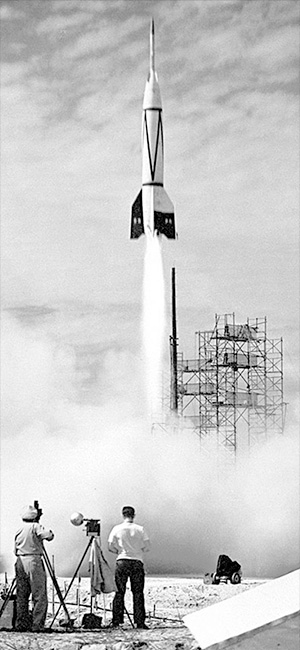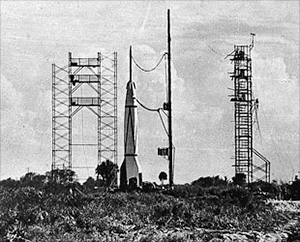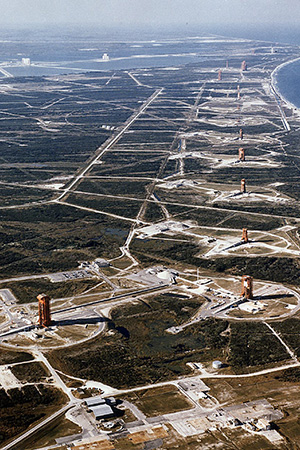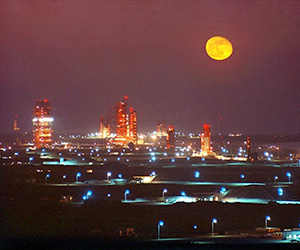July 23, 2010 — Sixty years ago Saturday morning (July 24), a 62-foot rocket stood ready to launch from the east coast of Florida, destined to make history — not so much for where it was going, but for where it was departing.
Bumper 8, a two-stage vehicle built from a U.S.-modified, World War II-captured German V-2 missile and a sounding rocket upper-stage, became the first to liftoff from what is now known as Cape Canaveral.
A ceremony to mark the 60th anniversary of Bumper 8's historic flight will take place today at the Florida launching pad.
Florida's first rocket
The launch, which took place on July 24, 1950, at 9:28 a.m. EDT (1428 GMT), established the Florida spaceport long before space was the objective.
"It was only about missile research," Michael Neufeld, chair of the National Air and Space Museum's Space History Division, told SPACE.com. "The Cape as a launch site emerged in the late '40s when the armed services were looking at developing missiles longer than the White Sands [New Mexico] range could accommodate."
"There was an inter-service examination where an appropriate long-range proving ground — that was what it was called, the first iteration [of Cape Canaveral] was called the Long Range Proving Ground — where it could be," Neufeld said.
Bumper 8, the seventh in a test series of launches that was named after the way the two stages separated — or bumped apart — at altitude, picked up at the Cape where the earlier tests in New Mexico had left off.
"What the 1950 tests were about, which is something that very few people know, is that these Bumper launches were not altitude-launches, like the Bumper that went to 250 miles after multiple failures," described Neufeld. "These Bumper launches were designed to go on a much flatter trajectory and gather some data about hypersonic flight more in the upper atmosphere. And that was explicitly connected to trying to develop long-range cruise missiles."
60 years of rocket history
As rocket launches go — or went in the six decades that followed — Bumper 8's two-minute flight was not a total success.
"Bumper 8 did not meet all its objectives," explained veteran space journalist Jim Banke, who will address an invited audience of Cape Canaveral personnel at a 60th anniversary ceremony this morning at the launch site.
"By and large, it was a successful mission in that it launched, it staged — which was the whole point of the flight to prove that staging could work and that the benefits of staging were real — but then after they staged they lost almost immediate contact and track with the WAC Corporal upper stage and they think that it basically broke apart," he added.
"Because of that — the mission did not meet all of its objective — so a lot of people used to call it a failure," said Banke. "But now it seems like we want to call it a success only it didn't meet all of its objectives."
Though it was impossible for the Bumper 8 team to know then, their 'successful failure' entered the history books for something other than own test objectives.
"I think that Bumper 8's real significance is that it was simply the first launch [from Cape Canveral]. I don't think the Bumper launches were even successful at the Cape. But that launch certainly places that significant marking point when the Cape began," Neufeld said.
"Bumper 8 was the first launch from Cape. It was the beginning of a 60-year now long tradition of excellence, of teamwork, or people doing miraculous things for the good of all. That's why it was important and that's why it is important here. It's usually a local legacy, a heritage thing, something we are proud of in own our backyard," said Banke.
Since Bumper 8, more than 3,000 rockets, missiles and manned spacecraft have followed its path skyward from the Florida launch-site. It was the latter though, that captured the public's imagination and really put Cape Canaveral on the map.
"In the '60s of course, it became the human spaceflight center and that is what everybody thought about, knew about. The fact that military activity continued there was increasingly obscured by the overwhelming focus on the human spaceflight program," Neufeld said. "I don't think most of the people are aware that most of the territory is in the Air Force side and that's where most of the launches are because [NASA's] Kennedy Space Center has all the visibility."
Out of space shuttles, out of sight?
"I think if you look to the non-space buff crowd, nobody knows about what is going on [at Cape Canaveral] except that the space shuttle is launched. They may have the vaguest knowledge that other rockets are launched there, but the overwhelming public image is that of the shuttle and that's where the shuttles are launched. So I wonder what people think is going to happen to the place," said Neufeld.
"The impression that I get is that if the public thinks of it all, it is when the shuttle launches and those are technically not even at Cape Canaveral," said Joel Powell, author of the 2006 book, "Go For Launch: An Illustrated History of Cape Canaveral." "The public doesn't really take a lot of notice [of rocket launches] — even when the Mars Exploration Rovers were launched to Mars or even the Lunar Reconnaissance Orbiter — they really don't notice them anymore."
"The shuttle is still capturing their attention but of course the shuttle is going away," he remarked.
As for the site itself, Powell said that Cape Canaveral is also losing much of its landscape to the passage of time. "The impression that I get when I visit recently is that it is slowly reverting back to its natural state, except for the active launch pads."
"I am a little bit saddened that most of the older launch pads have really been demolished and obliterated so that slowly, all the historical facilities are being literally plowed into the ground," said Powell, who added that Pad 3, where Bumper 8 lifted off, is now little more than a slab of concrete.
Launch site markers
Although Banke agreed that many of the historic sites are now shells of their former selves — 'ruins of Canaveral,' as Powell phrased it in his book — he feels the Cape is still adapting to fit the needs of those seeking to reach space.
"As the old stuff kind of fades away and almost disappears into the soil, new stuff is coming up, new pads, new prospects, new offices are being built to replace them as the Cape continues to meet the needs of the launch community," said Banke.
"We continue to be a launch site, we continue to be a gateway to Earth orbit and whatever happens at Kennedy Space Center in the near future in terms of NASA's space exploration agenda, Cape Canaveral Air Force Station is going to continue to be the major site in the United States for launching large cargo and satellites into orbit." |
|

Bumper 8 lifts off on July 24, 1950 from the Long Range Proving Grounds in Cape Canaveral, Florida. (NASA)

Bumper 8, poised on Pad 3 at the Long Range Proving Grounds in Cape Canaveral awaits its launch on July 24, 1950. (NASA)

Aerial view captured in 1964 of the string of launch pads called 'Missile Row' at the Cape Canaveral Air Force Station. (NASA)

A full moon is outdazzled by the lights of the launch gantries on Missile Row as they stretch along Cape Canaveral. (NASA) |
